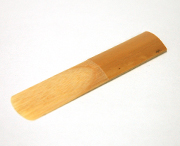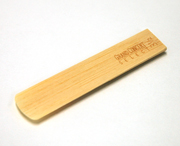Woodwind Family
Share
The Structure of the Woodwinds
What is the reed?
Making sound by vibrating the reed
The sound of a woodwinds, except flutes, are generated by vibrating the reed attached to the mouthpiece, which the player puts in his mouth. Instruments that make sound in this way are called reed instruments. The oboe and clarinet are also members of the reed instrument family.
What is the reed made of?
The reed is made of the cane plant.The cane has a hollow stem and grows to full height in one year. To make a reed, cane is cut to the proper length, cut along the length into four parts, and then shaved.
Because reeds are made from a natural material, no two reeds are exactly the same. This is why it is so important to choose the right reeds for the best sound. Take the time to learn how to choose reeds well.

Reed: lower lip side

Reed: mouthpiece side
Look for a mouthpiece that suits you
Mouthpieces are interchangeable, so most of them will fit any neck. Even if the mouthpiece is a little too loose or too tight, the cork can be easily shaved or replaced, so you can choose any mouthpiece you like.
We recommend that beginners start out with a standard mouthpiece (for Yamaha, this is the 4C) together with a 2 1/2 reed, and practice the basics of playing long tones, making sure to get their embouchure (the shape and action of the mouth and lips that controls the sound using the muscles around the mouth) correct, and from there go on to choose something that fits their taste.
The relationship between mouthpiece and reed selection
The most important factor in selecting a reed is the reed thickness.
Reed thickness is most often expressed as a number. The normal range for reeds is 2 to 5: the lower the number, the thinner the reed, and the higher the number, the thicker the reed. The thickness of the reed will affect the tone and how easy or difficult the instrument is to play. In general, a thinner reed, say 2 or 2.5, will have a brighter tone. Thinner reeds vibrate more easily, so they are good for beginners. Players of popular music or jazz often prefer this brighter tone and thus use thinner reeds. Reeds with a thickness of 4 or 5 are harder and thus require more skill to sound, but the tone is fatter, bigger, and warmer.
By the way, the reed is a consumable item and must be replaced often. This is sometimes a concern, so, recently, convenient resin reeds that are easy to maintain and last a long time have appeared.
